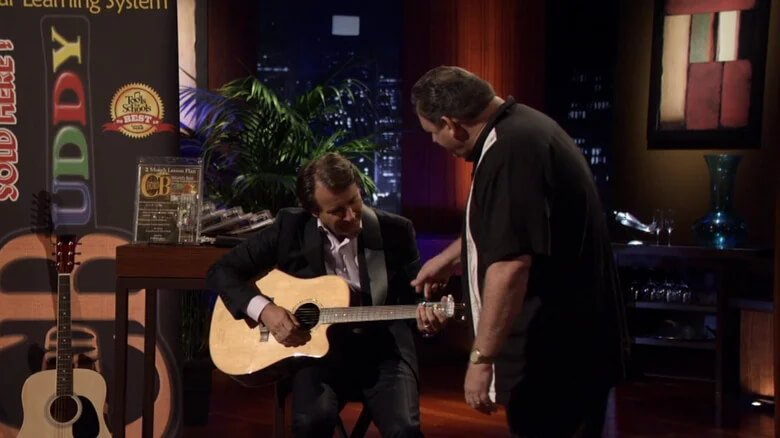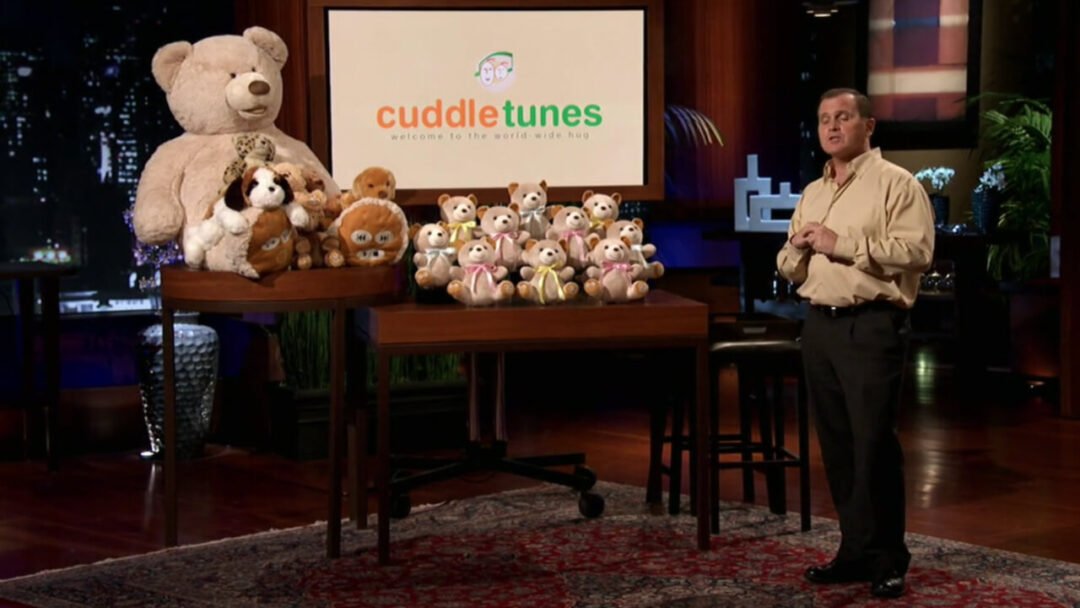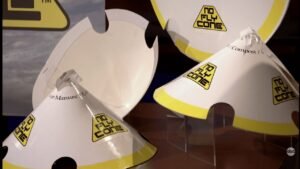Too many people tune in to Shark Tank, see a quirky gadget, and think, I could’ve done that. But here’s the reality: most products flame out. ChordBuddy was different. This was a solution born in frustration, not a boardroom.
Travis Perry, a musician and teacher from LA—Lower Alabama, designed ChordBuddy because his kid (and tons of students) kept quitting guitar. His device promised to fix the #1 reason people stop: learning the basics just hurts. This wasn’t fluff or some as seen on TV nonsense. Perry actually solved a real pain point.
Every founder wants that magic bridge from living room prototype to real revenue. ChordBuddy chased it—on national TV, for millions of eyeballs. But the question is: does Shark Tank really make you rich, or just internet famous for a week?
2. The ‘Shark Tank’ Pitch
We’ve all seen the Shark Tank handshake—big grins, dramatic music, happy endings. But beneath the lights, it’s a brutal, numbers-first game. When Perry entered the Tank (Season 3, Episode 1), he had $150,000 in sales under his belt. That’s legit traction, and the Sharks sat up.
He wanted $125,000 for 10% equity. Ambitious? Maybe. But I’ve seen founders lowball or get bullied on valuation. Perry stood his ground and, more importantly, he had proof: actual guitar sales, not just wishful thinking.
His pitch stuck because he kept it simple and relatable. Perry showed the problem (frustrated learners giving up), walked the Sharks through the fix (ChordBuddy), and had a signature southern one-liner: I’m from LA… Lower Alabama. The humor worked, but the numbers did the heavy lifting.
Every interaction in that room comes down to trust and likability. Perry didn’t play a character, and Sharks can smell a fake from a mile away.

3. ChordBuddy Net Worth and Sales Numbers
So, let’s cut the small talk: did ChordBuddy make real money? Fast-forward to post-Tank, and the guitar assistant’s net worth has danced around the $1 million revenue mark annually. Estimates, according to SharkWorth, put the company’s present valuation around $5-6 million, based on product lines, brand strength, and steady online sales.
The initial Shark Tank spike, like for most products, was massive—a couple of Scrub Daddy-level weeks that nearly melted Perry’s website. But Perry did something many don’t: he kept the momentum. Instead of blowing cash on too much marketing too fast (classic rookie move), he scaled smarter. Country stars endorsed the product, retailers signed on, and new SKUs (like youth-sized guitars and ukuleles) shipped out.
Pro tip: that million-a-year figure isn’t retirement money, but it’s street survival and then some. For a guitar gadget to hold ground this long, that’s impressive. If you’re still selling in year ten, you’re doing something right.
4. Deal or No Deal: Sharks Weigh In
Let’s break down the deal room, play by play. Five offers hit the table—rare, and proof Perry had leverage:
- Mark Cuban bowed out quick. Love the product, don’t see you as a road warrior, he said. Translation: Cuban smelled burnout risk, not lack of product.
- Kevin O’Leary hit hard: $125,000 for 20%, plus his face on the box.
- Daymond John matched Kevin, plus the chance at a star endorsement (never underestimate those).
- Barbara Corcoran sweetened the deal: $175,000 for 20%, but $50,000 ringfenced for infomercials.
- Robert Herjavec pitched $125,000 for 20%. Perry liked Robert—both had kids, they spoke the same language—and asked him to match Barbara’s extra $50,000.
Robert agreed. The deal closed at $175,000 for 20%. Part of that—$50,000—was for infomercials only. Smart ask, by Perry. Too many founders get fixated on Shark names, but Perry played the room, saw who understood his why, and pushed for terms that helped scale real sales.
Classic founder wisdom: know the room, know your #1 lever, don’t get greedy.

5. Product Breakdown: How ChordBuddy Works
Here’s what’s in the box, minus all the music-teacher mumbo jumbo. ChordBuddy is a snap-on plastic gadget that attaches to the neck of most acoustic guitars. Instead of mashing strings with your fingertips (hard and painful for most newbies), you press color-coded buttons to play chords.
Comes with it: lesson books, DVDs, a massive songbook, and a clear, step-by-step path to weaning yourself off the gadget. It’s made for right-handed guitars only, sized to fit most beginner axes. If you can tie your shoes, you can use this device.
Why is that smart? Two reasons. First, learning guitar often stalls at chords—so ChordBuddy keeps you strumming songs from day one, building confidence. Second, you can strip away the buttons as your skills grow, so it’s truly a bridge, not a crutch. Perry didn’t invent the capo, but he cracked the hardest part of guitar learning: not giving up.
6. Explosive Growth or Plateau? Post-Shark Tank Moves
A killer Shark Tank pitch is just step one. So, did ChordBuddy explode or stall? For a while, it was bananas—several million in the first few Shark Tank-driven months. The infomercial campaign (which Perry fought hard for) worked. So did scoring John Rich, the country music star, as an official endorser. That added industry cred.
But unlike some Shark Tank viral products (think GrooveBook or Bombas), Perry didn’t try to build a mega-brand overnight. He kept production in Alabama, refused to outsource to Asia, and invested more slowly into new lines—like for kids and ukuleles.
Most infomercial fads fizzle in two years. ChordBuddy kept evergreen status by staying visible in music education circles, pushing positive Amazon reviews, and never letting the Shark Tank tie-in overshadow product quality. The result? Sales that leveled out, but didn’t crater—a rare feat.
Lesson: Sharks give you a big stage, but your systems and margins have to keep you standing when the show’s over.
7. Where Is ChordBuddy Now?
So what’s the 2025 reality check? ChordBuddy is still around, still privately owned by Travis Perry (Herjavec’s deal didn’t turn into a full handover), and still moving units through their main website (chordbuddy.com), Amazon, and select music shops.
Sales come from word-of-mouth, music teachers, and big Shark Tank rerun surges. In the last couple years, their annual revenue keeps hitting that $900K-$1.2M mark. They’ve added more SKUs and still only make the product in the United States. That’s rare these days but keeps their quality and story strong.
Amazon reviews are solid— lots of five-stars, a few plastics complaints, but mostly praise for helping real people actually play songs. That’s tough social proof you can’t buy.
8. Lessons Every Entrepreneur Can Learn
Look—Shark Tank isn’t a magic ATM. Perry’s story is textbook: solid product, real market pain, expert self-awareness. He didn’t let TV ego or investor dazzle push him into dumb moves.
Key takeaways for actual founders, not just fans:
- Be crystal clear on your numbers before you pitch. Perry had tight sales figures, real customer use, and production cost data.
- Don’t accept just any Shark—find one who shares your why. Perry felt kinship with Herjavec and got his deal sweetened.
- Use the Tank for exposure but prep for the aftershock. A viral moment is nothing if your supply chain crumbles or your reviews tank.
- Brand extensions are survival, not ego. Perry added guitars and ukes because customers wanted them—not just to look bigger.
- Own your process. Perry insisted on Made in USA. Margins are thinner, but his brand’s trust is way thicker.
Want to survive after the credits roll? Focus on process, not just PR.
9. Conclusion: The Real Value of Grinding Past TV
I’ve seen plenty of Shark Tank companies go broke chasing one-hit-wonder magic. ChordBuddy is the opposite. Perry built a business that doesn’t vanish when the viral wave crashes. Why? Because the problem—guitar quitters—never goes away, and the solution stays simple.
The real story here isn’t a TV handshake or a celebrity name drop. It’s about what happens after you get your shot. Perry did the scary stuff—scaled slow, listened to customers, and worked for every sale. The Sharks gave him a window; he did the rest grinding, not hoping.
For anyone who thinks Shark Tank is where fairy tales end—look at ChordBuddy. The show is just your first sale. What you do after? That’s what builds net worth, brand, and real legacy.
FAQs
1. Is ChordBuddy from Shark Tank still in business?
Yes, ChordBuddy is very much alive and selling in 2025. The product stays in stock on chordbuddy.com and gets regular orders from Amazon and music educators.
2. How much money did ChordBuddy actually make after Shark Tank?
While exact totals are private, ChordBuddy pulls in roughly $1 million a year—no overnight unicorn, but that’s a real, consistent income stream.
3. Did Robert Herjavec stay involved after the deal closed?
There’s no public record of Herjavec taking over day-to-day, but the Shark Tank partnership delivered a sharp bump. Travis Perry still owns the majority.
4. Is ChordBuddy only for beginners or can advanced players use it too?
ChordBuddy’s sweet spot is beginners—those struggling with chords. Once you learn, you don’t need it, but some advanced teachers use it for students who’ve hit a plateau.
5. Can you buy ChordBuddy outside of the U.S.?
Yes, international buyers can shop via Amazon or chordbuddy.com. Shipping times and rates vary depending on the country.
6. Are there rip-offs or cheaper alternatives to ChordBuddy?
Of course. Like any hit invention, the copycats came quick, but most reviews say ChordBuddy is sturdier and better designed.
7. What’s the current price of ChordBuddy and where’s the best place to buy it?
Prices sit around $40-$60, depending on the model and retailer. For authenticity (and warranty), buy from chordbuddy.com or Amazon.
8. Has the product changed since it aired on Shark Tank?
It’s mostly the same—improved plastics, better instructions, and new versions for kids and ukuleles, but nothing drastic.
9. How long does it take to learn the guitar using ChordBuddy?
Most users can play simple songs in the first few days. Full independence—no device—comes after a couple months of steady practice.
So next time someone calls Shark Tank an instant millionaire machine, tell them to check SharkWorth and look up ChordBuddy. Turns out, real business happens after the pitch—when the hard work starts and the deals go quiet.










